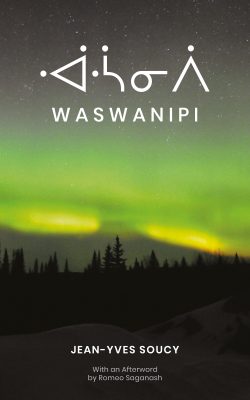Waswanipi is not now what it was in 1963 when the late Jean-Yves Soucy engaged with, learned from, and lived alongside the Cree community in the centre of Quebec. The community as it was then moved about forty-five kilometres up the Waswanipi River from its former location in 1965. This relocation highlights the importance of Soucy’s short but very readable and important piece of historic literature, Waswanipi.
In its brief 112 pages, readers are taken on a detailed tour of the boreal forest community with its peat bogs, streams, muskeg, black flies, people, and life. At the same time, a glimpse is caught of the real-time effects of colonial policies, as the Cree people’s land- scape is changed by settler governments in Quebec City and Ottawa chipping away at a traditional culture.
The story centres around Soucy’s summer job as a fire warden for the Department of Lands and Forests. “You’ll be fed up with the Indians soon enough,” his co-worker André says when the author/narrator arrives, want- ing to see the village. “I know them. They’re all the same: they’re lazy and they steal.”
André’s racism and bitterness stand in stark contrast to the actual people Soucy meets. Soucy’s guides are William Saganash (father of Cree lawyer and former NDP MP Romeo Saganash, who contributes an afterword to this translated edition) and Tommy Gull, two engaging, funny, and insightful men who take Soucy through the Cree territory and introduce him to their people’s traditions, as well as the hard reality of what is being lost under the Quebec and Canadian flags.

Waswanipi
Jean-Yves Soucy
Translated by Peter McCambridge
Baraka Books
$17.95
paper
112pp
9781771862530
At the trading post, a simple exchange with a young man named Simon Ottereyes highlights this skill. “I shake my head in disbelief when I realize the food costs four to five times more than in the ‘south,’” Soucy writes before introducing Ottereyes. “He’s about the same age as I am, and goes to a residential school in Sault Ste. Marie, Ontario.”
In two sentences, the reader is jolted to the reality that northern Indigenous people were, in 1963 as they are now, forced to pay steep prices for sustenance they once provided themselves with while, devastatingly, losing the opportunity to teach their children the ways, language, and culture of their people as they are shipped off to residential schools thousands of kilometres away.
“The government takes away our children every fall and brings them back the following summer,” Saganash says. “School… They no longer go with their parents to the winter hunting grounds. They’ve stopped learning how to hunt, trap and prepare the pelts. They no longer know how to live in the forest. They no longer know our traditions.” The micro-history that is Soucy’s memoir thus sheds a light on a much bigger and dark chapter of Canadian history.
However, the book is not one of gloom, but one of life and warmth. Despite the sadness, the Cree Soucy meets are not downcast, bitter, or disgruntled. Quite the opposite. They give the author, and the reader, a glimpse of a special and vibrant culture defending itself against foreign intrusion from industry, politics, and a colonial mindset forged in ignorance and arrogance.
“I used our break to ask William a little more about the spirits,” Soucy writes. “Do they have names? Do they also live inside people? He consults Tommy who replies at length with a rapid, monotonous delivery. There are wapinisou (spirit of the east), shawanisou (spirit of the south), chiwatinmisou (spirit of the north wind), and more.”
Simple and straightforward, much like Soucy’s guides.mRb






0 Comments